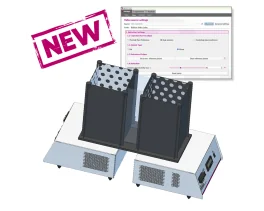Authors
V. Kayser, B. Aubel, M. Hamon, S. Bourgoin.
Lab
INSERM U288, NeuroPsychoPharmacologie Moléculaire, Cellulaire et Fonctionnelle, Paris, France.
Journal
British Journal of Pharmacology
Abstract
Peripheral lesion to the trigeminal nerve may induce severe pain states. Several lines of evidence have suggested that the antimigraine effect of the triptans with 5-HT1B/1D receptor agonist properties may result from inhibition of nociceptive transmission in the spinal nucleus of the trigeminal nerve by these drugs. On this basis, we have assessed the potential antinociceptive effects of sumatriptan and zolmitriptan, compared to dihydroergotamine (DHE), in a rat model of trigeminal neuropathic pain. Chronic constriction injury was produced by two loose ligatures of the infraorbital nerve on the right side. Responsiveness to von Frey filament stimulation of the vibrissal pad was used to evaluate allodynia. Two weeks after ligatures, rats with a chronic constriction of the right infraorbital nerve displayed bilateral mechanical hyper-responsiveness to von Frey filament stimulation of the vibrissal pad with a mean threshold of 0.38±0.04 g on the injured side and of 0.43±0.04 g on the contralateral (left) side (versus geqslant R: gt-or-equal,slanted 12.5 g on both sides in the same rats prior to nerve constriction injury). Sumatriptan at a clinically relevant dose (100 _g kg_1, s.c.) led to a significant reduction of the mechanical allodynia-like behaviour on both the injured and the contralateral sides (peak-effects 6.3±1.1 g and 4.4±0.7 g, respectively). A more pronounced effect was obtained with zolmitriptan (100 _g kg_1, s.c.) (peak-effects: 7.4±0.9 g and 3.2±1.3 g) whereas DHE (50–100 _g kg_1, i.v.) was less active (peak-effect _1.5 g). Subcutaneous pretreatment with the 5-HT1B/1D receptor antagonist, GR 127935 (3 mg kg_1), prevented the anti-allodynia-like effects of triptans and DHE. Pretreatment with the 5-HT1A receptor antagonist, WAY 100635 (2 mg kg_1, s.c.), did not alter the effect of triptans but significantly enhanced that of DHE (peak effect 4.3±0.5 g). In a rat model of peripheral neuropathic pain, which consisted of a unilateral loose constriction of the sciatic nerve, neither sumatriptan (50–300 _g kg_1) nor zolmitriptan (50–300 _g kg_1) modified the thresholds for paw withdrawal and vocalization in response to noxious mechanical stimulation. These results support the rationale for exploring the clinical efficacy of brain penetrant 5-HT1B/1D receptor agonists as analgesics to reduce certain types of trigeminal neuropathic pain in humans.
Source :
http://onlinelibrary.wiley.com/doi/10.1038/sj.bjp.0704979/full

 Pain - Thermal Allodynia / Hyperalgesia
Pain - Thermal Allodynia / Hyperalgesia Pain - Spontaneous Pain - Postural Deficit
Pain - Spontaneous Pain - Postural Deficit Pain - Mechanical Allodynia / Hyperalgesia
Pain - Mechanical Allodynia / Hyperalgesia Learning/Memory - Attention - Addiction
Learning/Memory - Attention - Addiction Physiology & Respiratory Research
Physiology & Respiratory Research











![Dynamic Weight Bearing 2.0 – Postural Module [Add-on]](https://bioseb.com/733-home_default/dynamic-weight-bearing-20-add-on-postural-module.jpg)
























 Pain
Pain Central Nervous System (CNS)
Central Nervous System (CNS) Neurodegeneration
Neurodegeneration Sensory system
Sensory system Motor control
Motor control Mood Disorders
Mood Disorders Other disorders
Other disorders Muscular system
Muscular system Joints
Joints Metabolism
Metabolism Cross-disciplinary subjects
Cross-disciplinary subjects CONFERENCES & MEETINGS
CONFERENCES & MEETINGS